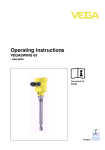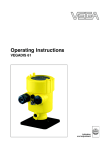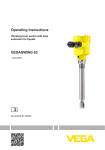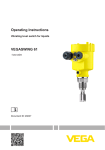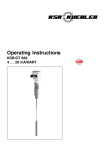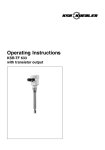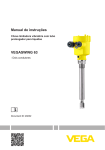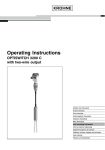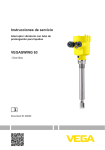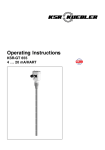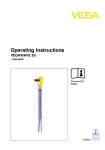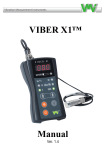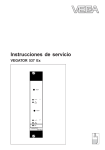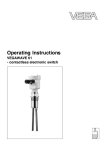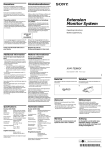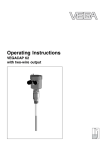Download Operating Instructions - VEGASWING 61 - - two-wire
Transcript
Operating Instructions VEGASWING 61 - two-wire Vibration Contents Contents 1 About this document 1.1 1.2 1.3 2 . . . . . . . . . . . . . . . . . . . . . . . . . . . . . . . . . . . . . . . . . . . . . . . . . . . . . . . . . . . . . . . .. .. .. .. .. .. .. .. .. Configuration. . . . . . . Principle of operation . Operation . . . . . . . . . Storage and transport . . . . . . . . . . . . . . . . . . . . . . . . . . . . . . . . . . . . . . . . . . . . . . . . . . . . . . . . . . . . . . . . . . . . .. 9 .. 9 . . 10 . . 11 General instructions. . . . . . . . . . . . . . . . . . . . . 12 Mounting instructions . . . . . . . . . . . . . . . . . . . . 15 Preparing the connection . . . . . . . . . . . Connection procedure . . . . . . . . . . . . . Wiring plan, single chamber housing. . . Wiring plan - version IP 66/IP 68, 1 bar. . . . . . . . . . . . . . . . . .. .. .. .. 17 17 18 20 In general . . . . . . . . . . . . . . . . Adjustment elements . . . . . . . . Function chart . . . . . . . . . . . . . Recurring test and function test . . . . . . . . . . . . . . . . . . . . . . . . . . . . . . . . . . . . . . . . .. .. .. .. 21 22 22 23 Maintenance and fault rectification Maintenance . . . . . . . . . . . . . . . . . . . . . . . . . . 26 Fault rectification . . . . . . . . . . . . . . . . . . . . . . . 26 Instrument repair . . . . . . . . . . . . . . . . . . . . . . . 27 VEGASWING 61 - - two-wire 29227-EN-070614 7.1 7.2 7.3 2 . . . . . . . . . Set up 6.1 6.2 6.3 6.4 7 . . . . . . . . . Connecting to power supply 5.1 5.2 5.3 5.4 6 6 6 6 6 6 7 7 7 8 . . . . . . . . . Mounting 4.1 4.2 5 Authorised personnel . . . . . . . . Appropriate use. . . . . . . . . . . . Warning about misuse . . . . . . . General safety instructions . . . . CE conformity . . . . . . . . . . . . . SIL conformity . . . . . . . . . . . . . Safety instructions for Ex areas Manufacturer declaration . . . . . Environmental instructions . . . . Product description 3.1 3.2 3.3 3.4 4 5 5 5 For your safety 2.1 2.2 2.3 2.4 2.5 2.6 2.7 2.8 2.9 3 Function . . . . . . . . . . . . . . . . . . . . . . . . . . . . . Target group . . . . . . . . . . . . . . . . . . . . . . . . . . Symbolism used . . . . . . . . . . . . . . . . . . . . . . . Contents 8 Dismounting 8.1 8.2 9 Dismounting steps . . . . . . . . . . . . . . . . . . . . . . 28 Disposal . . . . . . . . . . . . . . . . . . . . . . . . . . . . . 28 Supplement 9.1 9.2 9.3 9.4 Technical data. . . . . . . . Dimensions . . . . . . . . . . Industrial property rights. Trademark . . . . . . . . . . . . . . . . . . . . . . . . . . . . . . . . . . . . . . . . . . . . . . . . . . . . . . . . . . . . . . . . . . . . . . .. .. .. .. 29 38 40 40 Supplementary documentation Information: Depending on the ordered version, supplementary documentation belongs to the scope of delivery. You find this documentation in chapter "Product description". Instructions manuals for accessories and replacement parts Tip: To ensure reliable setup and operation of your VEGASWING 61, we offer accessories and replacement parts. The associated documents are: 29227-EN-070614 l l VEGASWING 61 - - two-wire Operating instructions manual "Remote housing - VEGASWING" Operating instructions manual "Oscillator VEGASWING series 60" 3 About this document 1 About this document 1.1 Function This operating instructions manual provides all the information you need for mounting, connection and setup as well as important instructions for maintenance and fault rectification. Please read this information before putting the instrument into operation and keep this manual accessible in the immediate vicinity of the device. 1.2 Target group This operating instructions manual is directed to trained personnel. The contents of this manual should be made available to these personnel and put into practice by them. 1.3 Symbolism used Information, tip, note This symbol indicates helpful additional information. Caution: If this warning is ignored, faults or malfunctions can result. Warning: If this warning is ignored, injury to persons and/or serious damage to the instrument can result. Danger: If this warning is ignored, serious injury to persons and/or destruction of the instrument can result. Ex applications This symbol indicates special instructions for Ex applications. l à 1 List The dot set in front indicates a list with no implied sequence. Action This arrow indicates a single action. Sequence Numbers set in front indicate successive steps in a procedure. 29227-EN-070614 4 VEGASWING 61 - - two-wire For your safety 2 For your safety 2.1 Authorised personnel All operations described in this operating instructions manual must be carried out only by trained specialist personnel authorised by the operator. During work on and with the device the required personal protection equipment must always be worn. 2.2 Appropriate use VEGASWING 61 is a sensor for level detection. You can find detailed information on the application range in chapter "Product description". 2.3 Warning about misuse Inappropriate or incorrect use of the instrument can give rise to application-specific hazards, e.g. vessel overfill or damage to system components through incorrect mounting or adjustment. 2.4 General safety instructions This is a high-tech instrument requiring the strict observance of standard regulations and guidelines. The user must take note of the safety instructions in this operating instructions manual, the country-specific installation standards as well as all prevailing safety regulations and accident prevention rules. The instrument must only be operated in a technically flawless and reliable condition. The operator is responsible for troublefree operation of the instrument. The user is also obliged to determine, during the entire duration of use, the compliance of the necessary occupational safety measures with the current valid regulations and take note of new regulations. 2.5 CE conformity 29227-EN-070614 VEGASWING 61 is in CE conformity with EMC (89/336/EWG), fulfils NAMUR recommendation NE 21 and is in CE conformity with LVD (73/23/EWG). Conformity has been judged according to the following standards: VEGASWING 61 - - two-wire 5 For your safety l EMC: - Emission EN 61326/A1: 1998 (class B) - Susceptibility EN 61326: 1997/A1:1998 l LVD: EN 61010-1: 1993 2.6 SIL conformity VEGASWING 61 fulfills the requirements to functional safety according to IEC 61508 resp. IEC 61511. You find further information in the Safety Manual "VEGASWING series 60". 2.7 Safety instructions for Ex areas Please note the Ex-specific safety information for installation and operation in Ex areas. These safety instructions are part of the operating instructions manual and come with the Exapproved instruments. 2.8 Manufacturer declaration In conformity with DIN EN 60079-14/2004, para. 5.2.3, point c1, VEGASWING 61 is suitable for use in zone 2. The operator must use the instrument as it was intended to be used and follow the specifications of the following documents: l l l this operating instructions manual this manufacturer declaration (24650) the valid installation regulations Max. increase of the surface temperature during operation: 35 K (individual components in the instrument) With an ambient temperature of 70 °C (158 °F) on the housing and a process temperature of 70 °C (158 °F), the max. ambient temperature during operation is 105 °C (221 °F). Measures to maintain explosion protection during operation: l l VEGASWING 61 - - two-wire 29227-EN-070614 6 Operate the instrument in the range of the specified electrical limit values. Permissible supply voltage: see "Technical data" Mount and operate the instrument in such a way that no danger of ignition by electrostatic charges is to be expected. Process fitting, plastic-coated probe part or housing (as the case may be depending on instrument version) are made of electrically non-conductive plastic. For your safety l l l l l l Make sure that the seal is mounted correctly between lower part of the housing and cover. Screw the cover on tightly. Make sure there is no explosive atmosphere present if you intend to operate the instrument with opened cover Make sure that the cable gland is tight and strain-relieved. The outer diameter of the connection cable must be adapted to the cable gland. Tighten the pressure screw of the cable gland carefully. Cover unused openings for cable glands tightly Mount the instrument in such a way that the sensor cannot touch the vessel wall or vessel installations. Keep in mind the influence of product movement in the vessel. The surface temperature of the housing must not exceed the ignition temperature of the surrounding explosive atmosphere This instrument was assessed by a person who fulfils the DIN EN 60079-14 requirements. 2.9 Environmental instructions Protection of the environment is one of our most important duties. That is why we have introduced an environment management system with the goal of continuously improving company environmental protection. The environment management system is certified according to DIN EN ISO 14001. Please help us fulfil this obligation by observing the environmental instructions in this manual: l Chapter "Packaging, transport and storage" Chapter "Disposal" 29227-EN-070614 l VEGASWING 61 - - two-wire 7 Product description 3 Product description 3.1 Configuration Scope of delivery The scope of delivery encompasses: l l Components VEGASWING 61 level sensor Documentation - this operating instructions manual - Safety Manual "Functional safety according to IEC 61508 or IEC 61511 (SIL)" - Supplementary instructions manual "Plug connector for level sensors" (optional) - Ex-specific "Safety instructions" (with Ex-versions) - if necessary, further certificates VEGASWING 61 consists of the following components: l l l Housing cover Housing with electronics process fitting with tuning fork 1 2 3 Fig. 1 2 3 1: VEGASWING 61 with plastic housing Housing cover Housing with electronics Process fitting 3.2 Principle of operation Area of application VEGASWING 61 is a level sensor with tuning fork for level detection. 8 VEGASWING 61 - - two-wire 29227-EN-070614 It is designed for industrial use in all areas of process technology and can be used in liquids. Product description Typical applications are overfill and dry run protection. With a tuning fork of only 40 mm length, VEGASWING 61 can be also mounted, e.g. in pipelines from DN 25. The small tuning fork allows use in vessels, tanks and pipes. Thanks to its simple and robust measuring system, VEGASWING 61 is virtually unaffected by the chemical and physical properties of the liquid. It functions even under difficult conditions such as turbulence, air bubbles, foam generation, buildup, strong external vibration or changing products. Fault monitoring The electronics module of VEGASWING 61 continuously monitors via frequency evaluation the following criteria: l l l Strong corrosion or damage on the tuning fork loss of vibration Line break to the piezo drive If one of these faults is detected, the electronics signals it via a defined current to the signal conditioning instrument. The connection cable to the sensor is also monitored on line break and short-circuit. Functional principle The tuning fork is piezoelectrically energised and vibrates at its mechanical resonance frequency of approx. 1200 Hz. The piezos are fixed mechanically and are hence not subject to temperature shock limitations. The frequency changes when the tuning fork is covered by the medium. This change is detected by the integrated oscillator, transferred as current value to the signal conditioning instrument and converted there into a switching command. Supply Depending on your requirements, VEGASWING 61 with twowire electronics can be connected to different signal conditioning instruments. Compatible signal conditioning instruments are listed in chapter "Technical data". The data for power supply are stated in chapter "Technical data" in the "Supplement". 3.3 Operation 29227-EN-070614 The switching condition of VEGASWING 61 with plastic housing can be checked when the housing is closed (signal lamp). In the basic adjustment, products with a density >0.7 g/ cm³ (0.025 lbs/in³) can be detected. The instrument can be adapted if products with lower density should be measured. VEGASWING 61 - - two-wire 9 Product description On the electronics module you will find the following indicating and adjustment elements: l l signal lamp for indication of the switching condition (green/ red) DIL switch for adaptation to the product density 3.4 Storage and transport Packaging Your instrument was protected by packaging during transport. Its capacity to handle normal loads during transport is assured by a test according to DIN EN 24180. The packaging of standard instruments consists of environment-friendly, recyclable cardboard. In addition, the sensor is provided with a protective cover of ABS. For special versions PE foam or PE foil is also used. Dispose of the packaging material via specialised recycling companies. Storage and transport temperature l l Storage and transport temperature see "Supplement Technical data - Ambient conditions" Relative humidity 20 … 85 % 29227-EN-070614 10 VEGASWING 61 - - two-wire Mounting 4 Mounting 4.1 General instructions Switching point In general, VEGASWING 61 can be mounted in any position. The instrument must be mounted in such a way that the tuning fork is at the height of the requested switching point. The tuning fork has lateral markings (notches) that indicate the switching point with vertical mounting. The switching point refers to water with the basic setting of the sensitivity switch >=0.7 g/cm³ (0.025 lbs/in³). When mounting VEGASWING 61, make sure that this marking is at the height of the requested switching point. Keep in mind that the switching point of the instrument is shifted if the medium has a density other than water - water =1 g/cm³ (0.036 lbs/in³). For products <0.7 g/cm³ (0.025 lbs/in³) and >0.5 g/cm³ (0.018 lbs/in³) the density switch must be set to >=0.5 g/cm³. Keep in mind that foams with a density >0.45 g/cm³ (0.016 lbs/ in³) are detected by the sensor. This can cause faulty switchings particulary when used as dry run protection system. 2 1 4 3 29227-EN-070614 Fig. 1 2 3 4 VEGASWING 61 - - two-wire 2: Vertical mounting Switching point approx. 13 mm (0.51 in) Switching point with lower density Switching point with higher density Switching point approx. 27 mm (1.06 in) 11 Mounting 1 Fig. 3: Horizontal mounting 1 Switching point 2 1 Fig. 4: Vertical installation (recommended installation position, especially for adhesive products) 1 Switching point 2 Marking with screwed version on top, with flange versions directed to the flange holes With flange versions, the fork is directed as follows to the flange holes. Fig. 5: Fork position with flange versions Moisture Use the recommended cables (see chapter "Connecting to power supply") and tighten the cable gland. 12 VEGASWING 61 - - two-wire 29227-EN-070614 You can give your VEGASWING 61 additional protection against moisture penetration by leading the connection cable downward in front of the cable entry. Rain and condensation Mounting water can thus drain off. This applies mainly to mounting outdoors, in areas where moisture is expected (e.g. by cleaning processes) or on cooled or heated vessels. Fig. 6: Measures against moisture penetration Transport Do not hold VEGASWING 61 on the tuning fork. Particularly with flange or tube versions, the tuning fork can be damaged just by the weight of the instrument. Transport coated instruments very carefully and avoid touching the tuning fork. Remove the protective cover just before mounting. Pressure/Vacuum The process fitting must be sealed if there is gauge or low pressure in the vessel. Before use, check if the seal material is resistant against the measured product and the process temperature. The max. permissible pressure is stated in chapter "Technical data" in the "Supplement" or on the type label of the sensor. Handling The vibrating level switch is a measuring instrument and must be treated accordingly. Bending the vibrating element will destroy the instrument. Warning: The housing must not be used to screw the instrument in! Applying tightening force on the housing can damage its rotational mechanical parts. 29227-EN-070614 To screw in, use the hexagon above the thread. VEGASWING 61 - - two-wire 13 Mounting 4.2 Mounting instructions Welded socket VEGASWING 61 has a defined thread starting point. This means that every VEGASWING 61 is in the same fork position after being screwed in. Remove therefore the supplied seal from the thread of VEGASWING 61. This seal is not required when using a welded socket with O-ring in front. Keep in mind that this welded socket is not suitable for coated instrument versions. Screw VEGASWING 61 completely into the welded socket. The later position can be determined already before welding. Mark the appropriate position of the welded socket. Before welding, unscrew VEGASWING 61 and remove the rubber ring from the welded socket. The welded socket has a marking (notch). Weld the socket with the notch facing upward, or in case of pipelines, aligned with the direction of flow. 1 Fig. 7: Marking on the welded socket 1 Marking Adhesive products In case of horizontal mounting in adhesive and viscous products, the surfaces of the tuning fork should be vertical in order to reduce buildup on the tuning fork. On the screwed version you will find a marking on the hexagon. With this, you can check the position of the tuning fork when screwing it in. When the hexagon touches the seal, the thread can still be turned by approx. half a turn. This is sufficient to reach the recommended installation position. With flange versions, the fork is directed to the flange holes. 14 VEGASWING 61 - - two-wire 29227-EN-070614 When used in adhesive and viscous products, the tuning fork should protrude into the vessel to avoid buildup. For that reason, sockets for flanges and mounting bosses should be avoided when mounting horizontally. Mounting If VEGASWING 61 is mounted in the filling stream, unwanted mismeasurements may result. Mount VEGASWING 61 at a location in the vessel where no disturbing influence from e.g. filling openings, agitators, etc. can occur. Flows To minimise flow resistance caused by the tuning fork, VEGASWING 61 should be mounted in such a way that the surfaces of the blades are parallel to the product movement. Enamel coating Instruments with enamel coating should be treated very carefully and shocks should be avoided. Unpack VEGASWING 61 directly before installation. Insert VEGASWING 61 carefully into the vessel opening and avoid touching any sharp vessel parts. 29227-EN-070614 Inflowing medium VEGASWING 61 - - two-wire 15 Connecting to power supply 5 Connecting to power supply 5.1 Preparing the connection Note safety instructions Always keep in mind the following safety instructions: l Connect only in the complete absence of line voltage Take note of safety instructions for Ex applications In hazardous areas you should take note of the appropriate regulations, conformity and type approval certificates of the sensors and power supply units. Select power supply Connect the power supply according to the following diagrams. Take note of the general installation regulations. As a rule, connect VEGASWING 61 to vessel ground (PA), or in case of plastic vessels, to the next ground potential. On the side of the instrument housing there is a ground terminal between the cable entries. This connection serves to drain off electrostatic charges. In Ex applications, the installation regulations for hazardous areas must be given priority. The data for power supply are stated in chapter "Technical data" in the "Supplement". Selecting connection cable VEGASWING 61 is connected with standard cable with round cross section. An outer cable diameter of 5 … 9 mm (0.2 … 0.35 in) ensures the seal effect of the cable gland. If cable with a different diameter or wire cross section is used, exchange the seal or use an appropriate cable connection. In hazardous areas, only use approved cable connections for VEGASWING 61. Select connection cable for Ex applications Take note of the corresponding installation regulations for Ex applications. 5.2 Connection procedure With Ex instruments, the housing cover may only be opened if there is no explosive atmosphere present. 16 1 Unscrew the housing cover 2 Loosen compression nut of the cable entry VEGASWING 61 - - two-wire 29227-EN-070614 Proceed as follows: Connecting to power supply 3 Remove approx. 10 cm (4 in) of the cable mantle, strip approx. 1 cm (0.4 in) insulation from the ends of the individual wires 4 Insert the cable into the sensor through the cable entry 5 Open the terminals with a screwdriver 6 Insert the wire ends into the open terminals according to the wiring plan 7 Tighten the terminals with a screwdriver 8 Check the hold of the wires in the terminals by lightly pulling on them 9 Tighten the compression nut of the cable entry. The seal ring must completely encircle the cable 10 Screw the housing cover back on The electrical connection is finished. 5.3 Wiring plan, single chamber housing The following illustrations apply to the non-Ex as well as to the EEx d version. Housing overview 4 4 1 2 3 8: Material versions, single chamber housing Plastic (not with EEx d) Aluminium Stainless steel (not with EEx d) Filter element for pressure compensation or blind stopper with version IP 66/ IP 68, 1 bar (not with EEx d) 29227-EN-070614 Fig. 1 2 3 4 4 VEGASWING 61 - - two-wire 17 Connecting to power supply Electronics and connection compartment SW E60Z 1 1 1- 36V D C + 0,5 g / cm3 2 0,7 g / cm3 1 2 3 4 Fig. 1 2 3 4 Wiring plan 9: Electronics and connection compartment, single chamber housing Control lamp DIL switch for sensitivity adjustment Ground terminal Screwed terminals We recommend connecting VEGASWING 61 in such a way that the switching circuit is open when there is a level signal, line break or failure (safe condition). For connection to a VEGATOR signal conditioning instrument dto. Ex, WHG. The sensor is powered by the connected VEGATOR signal conditioning instrument. Further information is available in chapter "Technical data" in the "Supplement", "Ex-technical data" are available in the supplied safety information manual. The wiring example is applicable for all suitable signal conditioning instruments. The control lamp on VEGASWING 61 lights in general l l red - with covered tuning fork green - with uncovered tuning fork Take note of the operating instructions manual of the signal conditioning instrument. Suitable signal conditioning instruments are listed in chapter "Technical data". 18 VEGASWING 61 - - two-wire 29227-EN-070614 If VEGASWING 61 is used in Ex areas as part of an overfill protection system according to WHG, take note of the regulations in the safety instructions and conformity certifi- Connecting to power supply cates. If VEGASWING with oscillator SWE60Z EX, SWE60Z EX E1 should be operated directly on the analogue input of a PLC, a suitable safety barrier should be connected. - + 1 2 1 2 3 4 Fig. 10: Wiring plan, single chamber housing 5.4 Wiring plan - version IP 66/IP 68, 1 bar Wire assignment, connection cable + 1 2 29227-EN-070614 Fig. 11: Wire assignment, connection cable 1 brown (+) and blue (-) to power supply or to the processing system 2 Screen VEGASWING 61 - - two-wire 19 Set up 6 Set up 6.1 In general The numbers in brackets refer to the following illustrations. Function/Configuration The switching condition of the electronics can be checked on the plastic housing with closed housing cover (control lamp). In the basic setting, products with a density >0.7 g/cm³ (0.025 lbs/ in³) can be detected. For products with lower density, the switch must be set to >0.5 g/cm³ (0.018 lbs/in³). On the electronics module you will find the following indicating and adjustment elements: l l Signal lamp (1) DIL switch for sensitivity adjustment (2) Mode switch (A/B) On the VEGATOR 536Ex, 537Ex, 636Ex signal conditioning instrument, via the signal conditioning instrument (when used according to WHG only mode A permitted). The switching condition can be changed with the A/B switch. You can set the required mode according to the "Function chart" (A - max. detection or overfill protection, B - min. detection or dry run protection). The integration time can also be modified on the signal conditioning instrument (VEGATOR 536Ex, 537Ex and 636Ex signal conditioning instruments). Note: For test purposes, immerse the tuning fork of VEGASWING 61 always in liquids. Do not test the function of VEGASWING 61 with the hand. This can damage the sensor. 29227-EN-070614 20 VEGASWING 61 - - two-wire Set up 6.2 Adjustment elements 1 2 1 2 Fig. 12: Oscillator SW E60Z - two-wire output 1 Signal lamp (LED) 2 DIL switch for sensitivity adjustment Signal lamp (1) Control lamp (LED) for indication of the switching status. l l l Sensitivity adjustment (2) green = tuning fork uncovered red = tuning fork covered off = failure With this DIL switch (2) you can set the switching point to liquids having a density between 0.5 and 0.7 g/cm³ (0.018 and 0.025 lbs/in³). With the basic setting, liquids with a density of >0.7 g/cm³ (0.025 lbs/in³) can be detected. In liquids with lower density, you must set the switch to >0.5 g/cm³ (0.018 lbs/in³). The specifications for the position of the switching point relate to water - density value 1 g/cm³ (0.036 lbs/in³). In products with a different density, the switching point will shift in the direction of the housing or tuning fork end depending on the density and type of installation. Keep in mind that foams with a density >0.45 g/cm³ (0.016 lbs/ in³) are detected by the sensor. This can cause faulty switchings particulary when used as dry run protection system. 6.3 Function chart 29227-EN-070614 The following chart provides an overview of the switching conditions depending on the adjusted mode and level. VEGASWING 61 - - two-wire 21 Set up Mode on Level the signal conditioning instrument Signal current Sensor Analogue - input control1) Mode A Overflow protection approx. 8 mA >3.6 mA <11 mA Mode A Overflow protection approx. 16 mA >13 mA <21 mA Mode B Dry run protection approx. 16 mA >13 mA <21 mA approx. 8 mA >3.6 mA <11 mA approx. 1.8 mA <=3.6 mA >=21.6 mA Signal lamp sensor Signal lamp signal conditioning instrument Green Red Red Mode B Dry run protection Green Fault message (mode A/B) any 6.4 Recurring test and function test According to WHG and IEC 61508. The implementation of the recurring test according to WHG is specified in the general type approval, see item 8 of the certificate. Take note of the overwhelming approvals, if VEGASWING 61 Ex is used as part of an overfill protection system according to WHG. 1) 22 Electronics directly evaluated via the analogue input of a control system (without signal conditioning instrument) VEGASWING 61 - - two-wire 29227-EN-070614 VEGASWING 61 in conjunction with a VEGATOR 636 Ex is qualified in mode A (overfill protection) for use in measuring chains of stage SIL2 according to IEC 61508 (redundant, stage SIL3). Set up WHG The following instrument combinations meet the requirements according to WHG: VEGASWING 61EX with l l SIL Oscillator SWE60Z EX VEGATOR 536EX, 537EX and 636EX signal conditioning instrument, VEGALOG or PLC The following instrument combinations meet the requirements according to SIL: VEGASWING 61EX l l Recurring test and function test Oscillator SWE60Z (EX) VEGATOR 636EX signal conditioning instrument The recurring test according to WHG and the function test according to IEC 61508 can be carried out by pushing the test key on the signal conditioning instrument or by briefly (>2 seconds) interrupting the cable to the sensor. The correct sequence of the switching conditions must be monitored via the two signal lamps on the signal conditioning instrument as well as the connected systems. The sensor must neither be removed nor must a response be triggered by filling the vessel. This applies to VEGASWING 61 with two-wire oscillator SWE60Z EX. If you are subject to the WHG regulations, you can carry out the function test with the outputted current values also directly via a PLC or a process control system. The implementation and switching sequence of the function test is described also in the operating instructions manual of the appropriate signal conditioning instrument. Test key on the signal conditioning instrument A function test can be carried out for measuring systems in conjunction with the two-wire oscillator SWE60Z. For this the integration time must be set to 0.5 s. The signal conditioning instrument has an integrated test key. The test key is recessed in the front plate of the signal conditioning instrument. Push the test key for >2 seconds with a suitable object (screwdriver, pen, etc.). 29227-EN-070614 For WHG the following also applies: If VEGASWING 61 is connected to a VEGALOG processing system or a PLC, you have to interrupt the connection cable to the sensor for >2 seconds. After releasing the test key or interrupting the connection cable to the sensor, the complete measuring system can be checked VEGASWING 61 - - two-wire 23 Set up on correct function. The following operating conditions are simulated during the test: l l l Fault message Empty signal Full signal Check if all three switching conditions occur in the correct sequence and the stated time period. If this is not the case, there is a fault in the measuring system (see also the operating instructions manual of the signal conditioning instrument). Keep in mind that connected instruments are activated during the function test. By doing this, you can check the correct function of the measuring system. (after releasing the test key) Test procedure Sensor current Sensor Level relay A overfill protection <2.0 mA currentless currentless currentless 2. Empty signal (approx. 1.5 s) approx. 8 mA energized energized 3. Full signal (approx. 1.5 s) approx. 16 mA currentless energized 1. Fault signal (approx. 3 s) With connection to PLC approx. 0.6 s Level relay B - dry run protection currentless Signal lamp A Overfill protection Signal Fail safe lamp B relay Dry run protection Control lamp energized 4. Return to the actual operating condition Note: When used as overfill protection according to WHG and use in measuring chains according IEC 61508, mode B is not permitted. 24 VEGASWING 61 - - two-wire 29227-EN-070614 You can carry out the function test with the outputted current values also directly with a PLC or a process control system (WHG). Maintenance and fault rectification 7 Maintenance and fault rectification 7.1 Maintenance When used as directed in normal operation, VEGASWING 61 is completely maintenance free. 7.2 Fault rectification Causes of malfunction VEGASWING 61 offers maximum reliability. Nevertheless faults can occur during operation. These may be caused by the following, e.g.: l l l l Sensor Process Supply Signal processing Fault clearance The first measure to be taken is to check the output signal. In many cases, the causes can be determined this way and the faults rectified. 24 hour service hotline However, if these measures are not successful, call the VEGA service hotline in urgent cases under the phone no. +49 1805 858550. The hotline is available to you 7 days a week round-the-clock. Since we offer this service world-wide, the support is only available in the English language. The service is free of charge, only the standard telephone costs will be charged. Checking the switching signal ? VEGASWING 61 signals "covered" when the vibrating element is not submerged (overfill protection) ? VEGASWING 61 signals "uncovered" when the vibrating element is submerged (dry run protection) l Supply voltage too low à Check the power supply l Electronics module defective 29227-EN-070614 à Press the mode switch (min./max.). If the instrument then changes the mode, the instrument may be mechanically damaged. Should the switching function in the correct mode still be faulty, return the instrument for repair. à Push the mode switch. If the instrument then does not change the mode, the oscillator may be defective. Exchange the oscillator. VEGASWING 61 - - two-wire 25 Maintenance and fault rectification à Check if there is buildup on the vibrating element, and if so, remove it. l Unfavourable installation location à Mount the instrument at a location in the vessel where no dead zones or air bubbles can form. l Wrong mode selected à Set the correct mode on the mode switch (max.: overfill protection,min.: dry run protection). Wiring should be carried out according to the quiescent current principle. ? Signal lamp flashes red l Electronics has detected a failure à Exchange instrument or return instrument for repair ? The signal lamp flashes alternately red and green l instrument defective à Exchange instrument or return instrument for repair 7.3 Instrument repair If a repair is necessary, please proceed as follows: You can download a return form (23 KB) from our homepage in the Internet www.vega.com under: "Downloads - Forms and Certificates - Repair form". By doing this you help us carry out the repair quickly and without having to call back for needed information. l l l l Print and fill out one form per instrument Clean the instrument and pack it damage-proof Attach the completed form and, if need be, also a safety data sheet outside on the packaging Please ask the agency serving you for the address of your return shipment. You can find the respective agency on our website www.vega.com under: "Company - VEGA worldwide" 29227-EN-070614 26 VEGASWING 61 - - two-wire Dismounting 8 Dismounting 8.1 Dismounting steps Warning: Before dismounting, be aware of dangerous process conditions such as e.g. pressure in the vessel, high temperatures, corrosive or toxic products etc. Take note of chapters "Mounting" and "Connecting to power supply" and carry out the listed steps in reverse order. With Ex instruments, the housing cover may only be opened if there is no explosive atmosphere present. 8.2 Disposal The instrument consists of materials which can be recycled by specialised recycling companies. We use recyclable materials and have designed the electronics to be easily separable. WEEE directive 2002/96/EG This instrument is not subject to the WEEE directive 2002/96/ EG and the respective national laws (in Germany, e.g. ElektroG). Pass the instrument directly on to a specialised recycling company and do not use the municipal collecting points. These may be used only for privately used products according to the WEEE directive. Correct disposal avoids negative effects to persons and environment and ensures recycling of useful raw materials. Materials: see chapter "Technical data" 29227-EN-070614 If you cannot dispose of the instrument properly, please contact us about disposal methods or return. VEGASWING 61 - - two-wire 27 Supplement 9 Supplement 9.1 Technical data General data Material 316L corresponds to 1.4404 or 1.4435 Materials, wetted parts - Process fitting - thread - Process fitting - flange 316L, Hastelloy C4 (2.4602) 316L, 316L with Hastelloy C4 coating, steel enamelled, 316L with ECTFE coating, 316L with PFA coating - Process seal Klingersil C-4400 - Tuning fork 316L, Hastelloy C4 (2.4610) - Extension tube ø 21.3 mm (0.84 in) 316L, Hastelloy C4 (2.4610), Hastelloy C4 (2.4610) enamelled, 316L with ECTFE coating, 316L with PFA coating Sensor length - length VEGASWING 61 - switching point as VEGASWING 81 or 81A Materials, non-wetted parts - Housing See "Supplement - Dimensions" +51 mm (+2 in) Plastic PBT (Polyester), Alu die-casting powder-coated, 316L - Seal between housing and housing cover NBR (stainless steel housing), silicone (Alu/ plastic housing) - Fibre-optic light guide in the housing cover PMMA (Makrolon) - Ground terminal 316L - Temperature adapter (optional) 316L - Gas-tight leadthrough (optional) 316L/glass Weights - Plastic housing 760 g (27 oz) - Aluminium housing 1170 g (41 oz) - Stainless steel housing 1530 g (54 oz) approx. 0.8 mm (0.03 in) - ECTFE approx. 0.5 mm (0.02 in) - PFA approx. 0.5 mm (0.02 in) 28 VEGASWING 61 - - two-wire 29227-EN-070614 Layer thickness - Enamel Supplement Surface quality - Standard Ra approx. 3 µm (1.18-4 in) - hygienic version (3A) Ra <0.8 µm (3.15-5 in) - hygienic version (3A) Ra <0.3 µm (1.18-5 in) Process fittings - Thread G¾ A, ¾ NPT, G1 A, 1 NPT - Flanges DIN from DN 25, ANSI from 1" - hygienic fittings Bolting DN 40 PN 40, Tri-Clamp 1", Tri-Clamp 1½" PN 10, conus DN 25 PN 40, Tuchenhagen Varivent DN 50 PN 10 High voltage test (enamel) max. 5 KV Gas-tight leadthrough (optional) - leakage rate <10-6 mbar l/s - Pressure resistance PN 64 - hygienic fittings Bolting DN 40 PN 40, Tri-Clamp 1", Tri-Clamp 1½" PN 10, conus DN 25 PN 40, Tuchenhagen Varivent DN 50 PN 10 Output variable Output Output signal - empty (uncovered) Two-wire output approx. 8 mA - full (covered) approx. 16 mA - Fault message <2.0 mA Possible signal conditioning instruments VEGATOR 536Ex, 537Ex, 636Ex, VEGALOG 571 Modes (adjustable via the signal conditioning instrument) - A Max. detection or overflow/overfill protection - B Min. detection or dry run protection Accuracy (similar to DIN EN 60770-1) 29227-EN-070614 Reference conditions and actuating variables according to DIN EN 61298-1 - Ambient temperature +18 … +30 °C (+64 … +86 °F) - Relative humidity 45 … 75 % - Air pressure 860 … 1060 mbar/86 … 106 kPa (12.5 … 15.4 psi) - Product temperature +18 … +30 °C (+64 … +86 °F) VEGASWING 61 - - two-wire 29 Supplement - Product density 1 g/cm³ (0.036 lbs/in³) (water) - Product viscosity 1 mPa s - Superimposed pressure 0 kPa - Sensor installation vertically from top - Density selection switch >0.7 g/cm³ Measuring accuracy Deviation ±1 mm (±0.04 in) Influence of the process temperature on the switching point 1 4 10 ( 25/64") 8 ( 5/16") 6 ( 15/64") 4 ( 5/32") 3 2 ( 5/64") 0 2 -2 (-5/64") -4 (-5/32") -6 (-15/64") -8 (-5/16") -10 (-25/64") 0 °C (32 °F) Fig. 1 2 3 4 50 °C (122 °F) 100 °C (212 °F) 150 °C (302 °F) 200 °C (392 °F) 250 °C (482 °F) 37: Influence of the process temperature on the switching point Shifting of the switching point in mm (in) Process temperature in °C (°F) Switching point at reference conditions (notch) Tuning fork Influence of the product density on the switching point 29227-EN-070614 30 VEGASWING 61 - - two-wire Supplement 1 6 10 ( 25/64") 8 ( 5/16") 6 ( 15/64") 4 ( 5/32") 5 2 ( 5/64") 0 2 -2 (-5/64") 4 -4 (-5/32") 3 -6 (-15/64") -8 (-5/16") -10 (-25/64") 0,6 (0,022) Fig. 1 2 3 4 5 6 0,8 (0,029) 1 (0,036) 1,2 (0,043) 1,4 (0,051) 1,6 (0,058) 1,8 (0,065) 2 (0,072) 2,2 (0,079) 2,4 (0,087) 38: Influence of the product density on the switching point Shifting of the switching point in mm (in) Product density in g/cm³ (lb/in³) Switch position 0.5 g/cm³ (corresponds to 0.018 lb/in³) Switch position 0.7 g/cm³ (corresponds to 0.025 lb/in³) Switching point at reference conditions (notch) Tuning fork 29227-EN-070614 Influence of the process pressure to the switching point VEGASWING 61 - - two-wire 31 Supplement 1 4 10 ( 25/64") 8 ( 5/16") 6 ( 15/64") 4 ( 5/32") 3 2 ( 5/64") 0 2 -2 (-5/64") -4 (-5/32") -6 (-15/64") -8 (-5/16") -10 (-25/64") 12 (174,1) Fig. 1 2 3 4 25 (362,6) 38 (551,1) 51 (739,7) 64 (928,2) 39: Influence of the process pressure to the switching point Shifting of the switching point in mm (in) Process pressure in bar (psi) Switching point at reference conditions (notch) Tuning fork Repeatability 0.1 mm (0.004 in) Hysteresis approx. 2 mm (0.08 in) with vertical installation Switching delay approx. 500 ms (on/off) Frequency approx. 1200 Hz Ambient conditions Ambient temperature on the housing -40 … +70 °C (-40 … +158 °F) Storage and transport temperature -40 … +80 °C (-40 … +176 °F) Process conditions Parameter Limit level of liquids Process pressure -1 … 64 bar (-14.5 … 938 psi) depending on the process fitting, e.g. flange (see following diagrams) VEGASWING 61 of 316L/Hastelloy C4 (2.4610) -50 … +150 °C (-58 … +302 °F) 29227-EN-070614 32 VEGASWING 61 - - two-wire Supplement Process temperature (thread or flange temperature) with temperature adapter (option) - VEGASWING 61 of 316L/Hastelloy C4 -50 … +250 °C (-58 … +482 °F) - VEGASWING 61 enamelled -50 … +200 °C (-58 … +392 °F) - VEGASWING 61 with ECTFE coating -50 … +150 °C (-58 … +302 °F) - VEGASWING 61 with PFA coating -50 … +150 °C (-58 … +302 °F) 2 3 70 °C (158 °F) 40 °C (104 °F) 0 °C (32 °F) -50 °C (-58 °F) 1 50 °C (122 °F) 100 °C (212 °F) 150 °C (302 °F) 200 °C (392 °F) 250 °C (482 °F) -40 °C (-40 °F) Fig. 1 2 3 40: Ambient temperature - Process temperature Process temperature in °C (°F) Ambient temperature in °C (°F) Temperature range with temperature adapter 1 64 (928) 40 (580) 20 (290) -1 (-14,5) 29227-EN-070614 -50 °C (-58 °F) 0 °C (32 °F) 50 °C (122 °F) 100 °C (212 °F) 150 °C (302 °F) 200 °C (392 °F) 250 °C (482 °F) 2 Fig. 41: Process temperature - Process pressure with switch position 0.7 g/cm³ (mode switch) 1 Process pressure in bar (psi) 2 Process temperature in °C (°F) VEGASWING 61 - - two-wire 33 Supplement 1 64 (928) 40 (580) 20 (290) -1 (-14,5) -50 °C (-58 °F) 0 °C (32 °F) 50 °C (122 °F) 100 °C (212 °F) 150 °C (302 °F) 200 °C (392 °F) 250 °C (482 °F) 2 Fig. 42: Process temperature - Process pressure with switch position 0.5 g/cm³ (mode switch) 1 Process pressure in bar (psi) 2 Process temperature in °C (°F) Viscosity - dynamic 0.1 … 10,000 mPa s (requirement: with density 1) Density 0.7 … 2.5 g/cm³ (0.025 … 0.09 lbs/in³); 0.5 … 2.5 g/cm³ (0.018 … 0.09 lbs/in³) by switching over Electromechanical data - version IP 66/IP 67 and IP 66/IP 68; 0.2 bar Cable entry/plug2) - Single chamber housing l 1x cable entry M20x1.5 (cable-ø 5 … 9 mm), 1x blind stopper M20x1.5 or: l 1x closing cap ½ NPT, 1x blind plug ½ NPT or: l for wire cross-section up to 1.5 mm² (0.0023 in²) Screw terminals Depending on the version M12x1, according to DIN 43650, Harting, Amphenol-Tuchel, 7/8" FF. VEGASWING 61 - - two-wire 29227-EN-070614 2) 34 1x plug (depending on the version), 1x blind plug M20x1.5 Supplement Electromechanical data - version IP 66/IP 68, 1 bar Cable entry - Single chamber housing l 1x IP 68 cable entry M20x1.5; 1x blind stopper M20x1.5 or: l Connection cable - Configuration 1x closing cap ½ NPT, 1x blind plug ½ NPT four wires, one suspension cable, one breather capillary, screen braiding, foil, mantle - Wire cross-section 0.5 mm² - wire resistance <0.036 Ohm/m (0.011 Ohm/ft) - Tensile strength >1200 N (270 pounds force) - Standard length 5 m (16.404 ft) - Max. length 1000 m (3280 ft) - Min. bending radius 25 mm (with 25 °C/77 °F) - Diameter approx. 8 mm - Colour - standard PE Black - Colour - standard PUR Blue - Colour - Ex-version Blue Adjustment elements Sensitivity switch - 0.5 - 0.5 … 2.5 g/cm³ (0.018 … 0.9 oz/in³) 0.7 0.7 … 2.5 g/cm³ (0.025 … 0.9 oz/in³) Voltage supply 11 … 36 V DC (via the signal conditioning instrument) Supply voltage Electrical protective measures 29227-EN-070614 Protection - Plastic housing IP 66/IP 67 - Alu and stainless steel standard IP 66/IP 68 (0.2 bar)3) - Alu and stainless housing (optionally available) IP 66/IP 68 (1 bar) Overvoltage category III 3) VEGASWING 61 - - two-wire Prerequisite for maintaining the protection is a suitable cable. 35 Supplement Protection class II Approvals4) ATEX II 1G 1/2G, 2G EEx ia IIC T6 ATEX II 1/2G, 2G EEx d IIC T65) ATEX II 1/2D IP6X T6) ATEX II 3G EEx nA II T5...T1 X T7) ATEX II 3G EEx nL IIC T68) IEC Ex Ex ia IIC T6 FM (NI) CL I, DIV 2, GP ABCD FM (XP) CL I, DIV 1, GP ABCD (DIP) CL II, III, DIV 1, GP EFG9) FM (IS) CL I, II, III, DIV 1, GP ABCDEFG Ship approvals 5) 6) 7) 8) 9) 36 Deviating data in Ex applications: see separate safety instructions. Only with Aluminium housing. Not with plastic housing. Not with plastic housing. Only with Aluminium housing. Only with Aluminium housing. VEGASWING 61 - - two-wire 29227-EN-070614 4) Supplement 9.2 Dimensions Housing in protection IP 66/IP67 and IP 66/IP 68; 0.2 bar 69mm (2 23/32") ø77mm (3 1/32") M20x1,5/ ½ NPT M20x1,5/ ½ NPT 1 Fig. 1 2 3 116mm (4 9/16") 116mm (4 9/16") ø84mm (3 5/16") 117mm (4 39/64") 112mm (4 13/32") 69mm (2 23/32") ø77mm (3 1/32") M20x1,5/ ½ NPT 2 M20x1,5 3 43: Housing versions in protection IP 66/IP 67 and IP 66/IP 68; 0.2 bar Plastic housing Stainless steel housing Aluminium housing Housing in protection IP 66/IP 68, 1 bar 116mm (4 9/16") ~ 150mm (5 29/32") ø 84mm (3 5/16") ø 77mm (3 1/32") 117mm (4 39/64") ~ 103mm (4 1/16") M20x1,5 M20x1,5 1 M20x1,5 2 29227-EN-070614 Fig. 44: Housing versions in protection IP 66/IP 68, 1 bar 1 Stainless steel housing 2 Aluminium housing VEGASWING 61 - - two-wire 37 Supplement 53 mm (2 3/32") 53 mm 50 mm (2 3/32") (1 31/32") Fig. 1 2 3 4 5 6 7 178 mm (7 1/64") 6 ø 33,7 mm (1 21/64") 4 3 34 mm (1 11/32") 2 19 mm (3/4") 1 55 mm (2 11/64") 57 mm (2 1/4") 36 mm (1 27/64") 32 (G3/4A, 3/4"NPT) 41 (G1A, 1"NPT) G3/4A, 3/4"NPT G1A, 1"NPT 53 mm (2 3/32") 66 mm (2 23/32") 18,5 mm (47/64") VEGASWING 61 7 5 45: VEGASWING 61 Thread Tri-Clamp Cone DN 25 Bolting DN 40 Flange Gas-tight leadthrough Temperature adapter 29227-EN-070614 38 VEGASWING 61 - - two-wire Supplement 9.3 Industrial property rights VEGA product lines are global protected by industrial property rights. Further information see http://www.vega.com. Only in U.S.A.: Further information see patent label at the sensor housing. VEGA Produktfamilien sind weltweit geschützt durch gewerbliche Schutzrechte. Nähere Informationen unter http://www.vega.com. Les lignes de produits VEGA sont globalement protégées par des droits de propriété intellectuelle. Pour plus d'informations, on pourra se référer au site http://www.vega.com. VEGA lineas de productos están protegidas por los derechos en el campo de la propiedad industrial. Para mayor información revise la pagina web http://www.vega.com. Линии продукции фирмы ВЕГА защищаются по всему миру правами на интеллектуальную собственность. Дальнейшую информацию смотрите на сайте http://www.vega.com. VEGA系列产品在全球享有知识产权保护。 进一步信息请参见网站<http://www.vega.com>。 9.4 Trademark 29227-EN-070614 All brands used as well as trade and company names are property of their lawful proprietor/originator. VEGASWING 61 - - two-wire 39 VEGA Grieshaber KG Am Hohenstein 113 77761 Schiltach Germany Phone +49 7836 50-0 Fax +49 7836 50-201 E-mail: [email protected] www.vega.com ISO 9001 All statements concerning scope of delivery, application, practical use and operating conditions of the sensors and processing systems correspond to the information available at the time of printing. © VEGA Grieshaber KG, Schiltach/Germany 2007 Subject to change without prior notice 29227-EN-070614








































